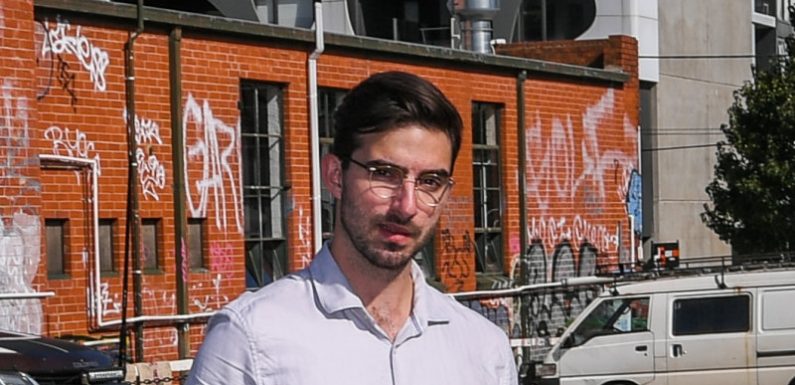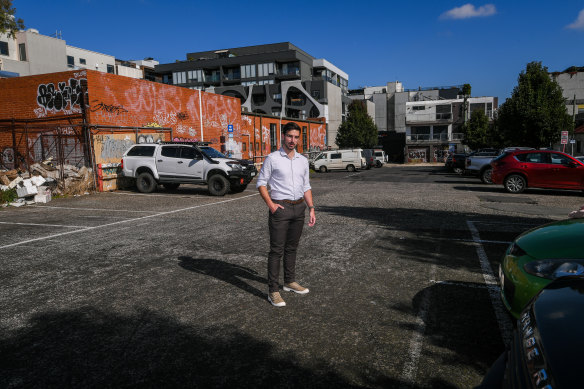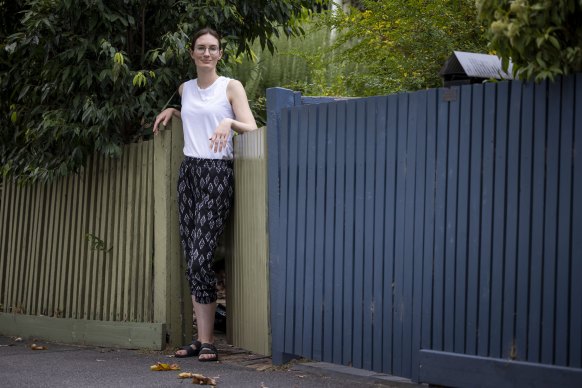
Save articles for later
Add articles to your saved list and come back to them any time.
Key points
- The Yes In My Back Yard (YIMBY) movement is gaining traction in Melbourne as a vocal counterpoint to local residents opposing new developments in their area.
- The housing activism group Melbourne New Progressives aims to build a groundswell of grassroots support for a local YIMBY movement.
- Max Holleran, social policy researcher at The University of Melbourne and author of Yes To The City, says the rise of the YIMBY movement in Melbourne reflects global trends.
They are young, educated, have good jobs – and they want to see more development, specially affordable housing, in their local neighbourhoods.
The Yes In My Back Yard movement – or YIMBYs – is gaining traction in Melbourne as a counterpoint to residents who oppose new developments in their local area.
Melbourne New Progressives organiser Jonathan O’Brien at the site of a rejected housing development in Brunswick.Credit: Justin McManus
Jonathan O’Brien, 27, started the housing activism group, Melbourne New Progressives, six months ago and wants to build grassroots support for a local YIMBY movement.
“The housing crisis is, behind the climate crisis, the biggest problem that we face as a society,” he says. “I think people are waking up to the fact that we’re going to need to do some pragmatic and complicated things in order to overcome it.”
O’Brien, an IT worker in the public service, says he grew frustrated by the dominance of the Not In My Back Yard (NIMBY) movement at local council meetings where development proposals are regularly opposed by residents.
“There aren’t really structures built into council meetings to hear about support for developments,” he says.
“We want to advocate on behalf of the people who don’t live in the area because they can’t afford to. We think more Melbournites is a good thing, we think more people should live in what we all think is one of the best cities in the world.”
The group is a spin-off from the Progressive Policy Institute in the United States. Its thesis is that too much power over decisions about new housing is left to relatively small bands of residents who attend council meetings to argue that whatever is being proposed is “out of character” and should be built somewhere else.
O’Brien points to a development application last month by sustainable housing group Nightingale in Brunswick as an example of the dominance of NIMBYism locally. A plan for a development that included a minimum of 10 per cent affordable community housing was rejected by Merri-Bek Council on grounds including the six-storey height of the development.
He says a particular issue in Melbourne is heritage overlays that make it difficult to develop affordable housing because of the value placed on protecting older buildings.
“We see the value to be found in housing itself, the ability for people to live in an area where they want to live, in a world where people can live near where they work and near the communities they want to be a part of,” he says. “That feels better to me than a world where we value bluestone structures that have one bedroom and a drop toilet.”
Katie Roberts-Hull says she was in the minority speaking in favour of development at a recent City of Melbourne council meeting. Credit: Wayne Taylor
The conflict between heritage protection and future development came to a head this month with the heritage listing of the Cardigan House car park, a brutalist 1970s car park in Carlton.
Resident Katie Roberts-Hull, who argued against the listing, said it highlighted the dominance of NIMBYism at the City of Melbourne meeting.
“I am a Carlton resident and I might be a little bit different than other people speaking to you because I generally want more development and more housing and more change to the neighbourhood,” she told the meeting.
Max Holleran, a social policy researcher at the University of Melbourne and author of the book, Yes to the City, says the rise of the YIMBY movement in Melbourne reflects global trends.
“[YIMBYs] say: ‘We need to stop just completely blanket demonising developers and development’,” he says.
Holleran says some YIMBYs are libertarian and want to scrap planning regulations altogether, while others are progressives who embrace social housing.
“Almost all of them are Millennials, a lot of them are people who see a gap between their status in terms of education and their professional jobs and then what they can afford,” he says.
“It’s where people are really securely middle class, have advanced degrees and have good jobs and they can’t get onto the property ladder.”
Holleran says the underlying sentiment driving YIMBYs is “wow, if I can’t afford a place to live, something’s really out of whack here”.
He says while heritage advocates are often viewed as a natural enemy of YIMBYs, there is a difference between the preservation of individual buildings and arguments about protecting the character of a neighbourhood itself.
“I think that’s where a lot of YIMBYs get a little bit sensitive because you can’t just freeze a place in aspic so it will remain the same forever,” he says. “Cities can’t be like Venice, where it just sits there and becomes a museum attraction. They have to be dynamic, they have to grow.”
Holleran says the rising cost of housing in Melbourne is a particular issue, with the city’s inner and middle suburbs increasingly unaffordable.
“Five years ago, before the pandemic, most people who were really talking about housing, were talking about … buying homes or buying apartments,” he says.
“Now with the rising rents, people are getting excluded from specific neighbourhoods, and they are a lot more rent burdened. That’s something that scares me because that reminds me of what happens in places like San Francisco and New York and Seattle, where first people fell off the property ladder, then they had trouble with their rent.”
Holleran says that five years ago housing activism was about where people could afford to buy and now it is about where people can afford to rent.
“It’s now a very middle-class issue as well, as you can make well over $100,000 and still be really strained in your ability to pay rent.”
The Morning Edition newsletter is our guide to the day’s most important and interesting stories, analysis and insights. Sign up here.
Most Viewed in National
From our partners
Source: Read Full Article

